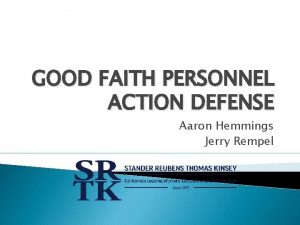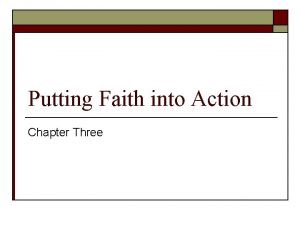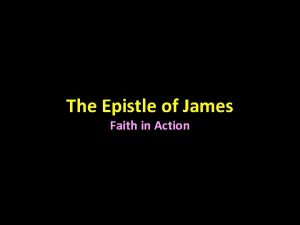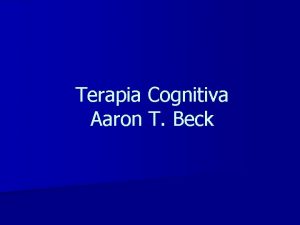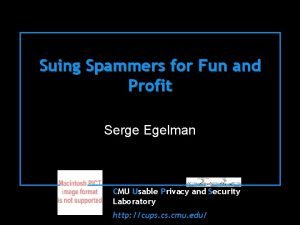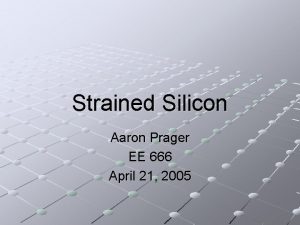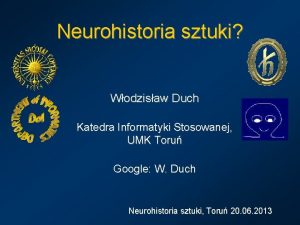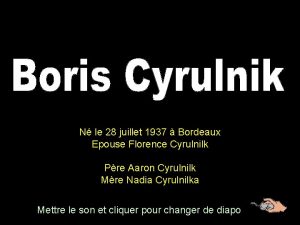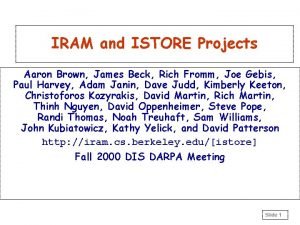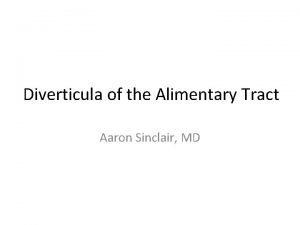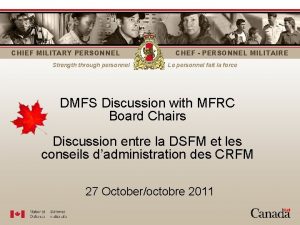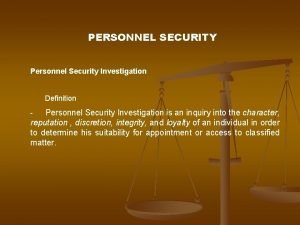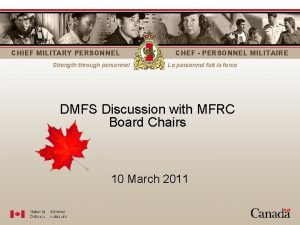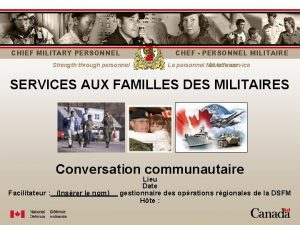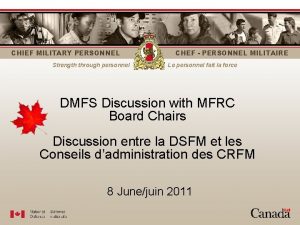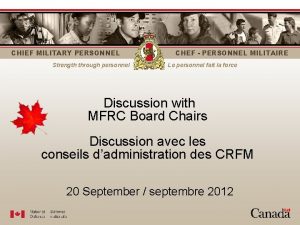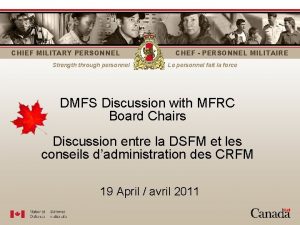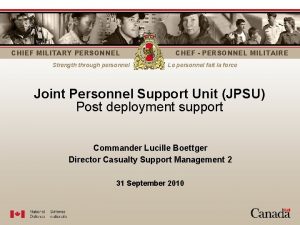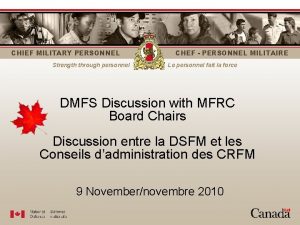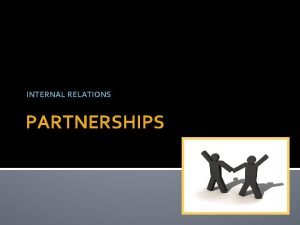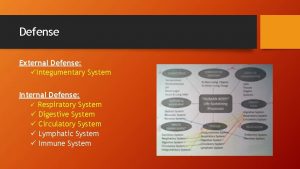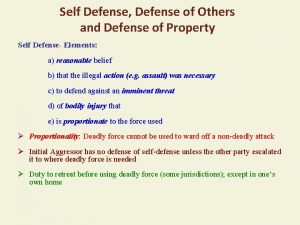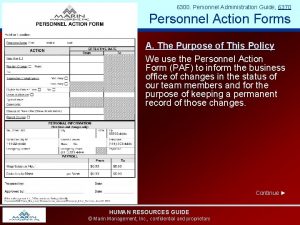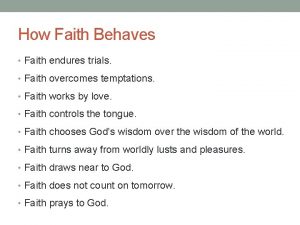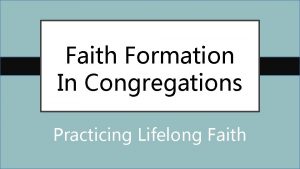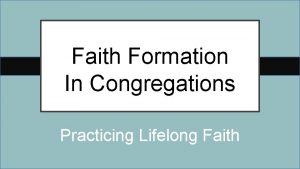GOOD FAITH PERSONNEL ACTION DEFENSE Aaron Hemmings Jerry














![FUJIMOTO � Your discussion should follow of the following format: � [Employment Event #1] FUJIMOTO � Your discussion should follow of the following format: � [Employment Event #1]](https://slidetodoc.com/presentation_image_h2/4e4079d4a7b26971da10401c59adfdce/image-15.jpg)





















- Slides: 36

GOOD FAITH PERSONNEL ACTION DEFENSE Aaron Hemmings Jerry Rempel

Good Faith Personnel Action Defense � Labor Code 3208. 3(h) provides that "No compensation. . . shall be paid by an employer for a psychiatric injury if the injury was substantially caused by lawful, nondiscriminatory good faith personnel action. "

Good Faith Personnel Action Defense � Although the term 'personnel action" has not been defined in the Labor Code, case law suggests that what constitutes a good faith personnel action must be tested against the facts of each case.

ROLDA � Sam worked as a traveling salesman, and he was counseled by his direct supervisor that his performance needed to improve. Sam says that he was advised by his supervisor that he should consider resigning, but this statement is in dispute. What is not in dispute is that the employer told him repeatedly that his performance was not up to standards and that he needed to improve his performance. It should be noted that Sam had a death in the family, and he needed to travel out of the country to take care of family business. So, he took a leave of absence. Once his leave time was exhausted, and Sam had not yet returned, the employer filled his position. However, upon his return, they offered him another position in another area, where he had to commute two hours in each direction. Sam filed a workers’ compensation claim alleging psychiatric injury.

ROLDA � Does the employer have a valid good faith personnel action defense? � What are the factors that a medical-legal evaluator would need to consider? � What are the issues that the judge would need to consider? � What do you need to do to develop the record to assert a good faith personnel action defense?

ROLDA � In 2001, the WCAB issued its en banc decision in Rolda v. Pitney Bowes, Inc. (2001) 66 CCC 241, where it applied Labor Code Section 3208. 3 to essentially the facts just set forth. � The Board determined that there were some factors that require a medical expert and some factors are factual/legal issues for a WCJ. � This case establishes the analytical framework for the application of the good faith personnel action defense.

ROLDA The multilevel analysis to be used by the trier of fact under Rolda is as follows: � (1) Whether the alleged psychological injury involves actual events of employment, a factual/legal determination; � (2) If so, whether such actual events were the predominant cause (i. e. accounting for 51% or more of the psychological injury), a determination which requires medical evidence; � (3) If so, whether any of the actual employment events were personnel actions that were lawful, nondiscriminatory, and in good faith, a factual/legal determination; and, � (4) If so, whether the lawful, nondiscriminatory, good faith personnel actions were a “substantial cause” (accounting for at least 35% to 40% of causation from all sources combined) of the psychological injury, a determination that requires medical evidence. �

ROLDA CONFUSION � With respect to the multi-level analysis, criteria, two of the four factors involve causation determinations. The initial causation determination, which requires medical evidence, is whether actual events were the predominant cause of the alleged psychological injury, which is a greater than 50% percentage requirement.

ROLDA CONFUSION � The second causation factor is to determine whether actual employment events were personnel actions that were lawful, nondiscriminatory, and in good faith. If so, were these lawful nondiscriminatory good faith personnel actions a “substantial cause” of the psychological injury, which is a causation standard that is different than the 51% predominant cause standard i. e. , a 35% to 40% range standard.

ROLDA CONFUSION � Unfortunately, it is these two causation factors or elements of the Rolda multi-level analysis criteria that continue to cause analytical short circuits, especially with respect to medical reporting that must comply with the substantial evidence standard.

FUJIMOTO � John is an auto body technician. It should be noted that body shops often have colorful characters and behavior that may not be acceptable in all settings. However, John asserts that he was harassed and emotionally abused in his employment. His allegations include placing dead rats on his tool box and drilling holes in the restroom wall and inserting a camera for the purpose of filming John in the john urinating. John also asserts that there was pornographic graffiti on the bathroom walls and extensive damage to his personal vehicle. The employer admits that there was inappropriate graffiti but denies all other allegations.

FUJIMOTO � At trial, the WCJ took it upon herself to request a supplemental report from the AME, and sent the following letter:

FUJIMOTO � “[Please provide a supplemental report that describes in detail, in accordance with Rolda, all the workplace and all the non-industrial related events and/or issues that combined caused the Applicant’s psychological injury. You are then to assign a percentage of causation separately to each individual work-related and/or nonindustrial event(s) and/or issue(s) that, when combined, equal 100% of the causation of the applicant’s psychological injury. You are not to combine percentages as to any multiple factors and/or issues, either industrial or non-industrial.

FUJIMOTO � It will ultimately be up to me to decide which workplace activities are actual events (i. e. , which of the event(s) described by the Applicant happened or not) and whether those events that I have deemed to be actual events are otherwise legitimate, non-discriminatory, good faith personnel actions. Based on this, I can determine if the actual events of employment, if added together, will result in them being the predominant cause (i. e. , more than 50%) of the Applicant’s psychological injury, and whether those actual causes were substantially caused (i. e. , 35% to 40%) by lawful, nondiscriminatory, good faith personnel actions.
![FUJIMOTO Your discussion should follow of the following format Employment Event 1 FUJIMOTO � Your discussion should follow of the following format: � [Employment Event #1]](https://slidetodoc.com/presentation_image_h2/4e4079d4a7b26971da10401c59adfdce/image-15.jpg)
FUJIMOTO � Your discussion should follow of the following format: � [Employment Event #1] – [Percentage of Causation] � [Employment Event #2] – [Percentage of Causation] � [Non-industrial Factors and/or Events #1] – [Percentage of Causation] � [Non-industrial Factors and/or Events #2] – [Percentage of Causation] � Total: 100%”

FUJIMOTO � This case illustrates both the problem and a practical analytical approach to these challenging dual causation issues. In Fujimoto v. Caliber Collision Centers (2014) 2014 Cal. Wrk. Comp. P. D. LEXIS 118 (WCAB panel decision), it was found the applicant did not sustain industrial injury to his psychological system as a result of the cumulative trauma injury based on the defense being able to successfully establish the affirmative “good faith personnel action” defense.

FUJIMOTO � In response to the WCJ’s letter, the AME identified eleven distinct and discrete industrial-related events/issues and one nonindustrial factor or event. The eleven industrial employment events totaled 90% and the nonindustrial factor or factors consisting of a preexisting dependent personality which contributed 10%, with a conclusion of employment events 90% and nonindustrial factors 10%.

FUJIMOTO � However, the WCJ found the applicant not credible with respect to all but one of the eleven industrial factors. The only industrial factor he found credible was the pornographic restroom graffiti. Since the applicant lacked credibility and the WCJ found the defense witnesses’ testimony credible, all of the alleged employment/work factors except one were deemed not to be actual events of employment by the WCJ. The only “actual event” was the obscene graffiti drawn on the restroom walls.

FUJIMOTO � This was not considered by the WCJ to be a lawful nondiscriminatory good faith personnel action. However, this one “actual event” of employment only constituted 4% of the causation of applicant’s psychological injury, far short of the 35% to 40% required. “Therefore given the lack of predominate causation due to ‘actual events’ of employment, the Applicant cannot be deemed to have suffered an industrial psychological injury. ”

FUJIMOTO � The WCJ directed the AME to separately assign a percentage figure and not combine percentages related to multiple factors. This approach resulted in a clear roadmap for the trier of fact to determine which of the discrete individual activities were “actual events” and in turn if those “actual events” were legitimate non-discriminatory, good faith personnel actions.

FUJIMOTO � It is suggested that the analytical approach formulated by the WCJ in his letter/interrogatory to the AME in this case may be a useful tool by the parties in drafting letters to reporting physicians in resolving the challenging and perplexing dual causation elements required by Rolda.

PERSONNEL ACTION � In a significant panel decision, guidelines for determining the existence of a “personnel action” were set forth in Larch v. Contra Costa County (1998) 63 CCC 831. � This case holds that a personnel action is conduct by management or attributable to management including such things as done by one who as authority to review, criticize, demote or discipline an employee. � Personnel actions may include transfers, demotions, layoffs, or performance evaluations and can include warnings, suspensions and termination.

PERSONNEL ACTION � Not every action by management will be construed as a “personnel action. ” In County of Butte v WCAB (Purcell) (2001) 65 CCC 1054 (writ denied), the WCAB held that memoranda from a supervisor to an employee did not constitute personnel actions because they did not suggest that the applicant was being disciplined, nor did they carry a threat of discipline.

PERSONNEL ACTION � The memoranda noted that Applicant had used unauthorized facilities in conducting a firearms class and also reflected disagreements between the Applicant and the police chief over firearms policy, and whether or not there was adequate communication up and down the chain of command. � The Applicant was reassigned to a new position. � Testimonial evidence suggested that the Chief was on a campaign to eliminate the Applicant.

PERSONNEL ACTION � Applicant testified he was under instructions to build cases against other employees whom the Chief wished to eliminate, the goal being to allow a basis for termination of these employees and a “streamlining” of the department. � The WCAB concluded that the applicant was a victim of a “culture clash” between himself and the new chief, and therefore LC 3208(h) did not bar his recovery for psychiatric injury.

PERSONNEL ACTION � At first blush, the question of whether or not an action was undertaken in “good faith” should be fairly easy to determine from the facts of the case: Was the action undertaken without ill-motive toward the employee, and was it within the range of activities foreseen in Larch? � Unfortunately, as with most technical defenses that bar an otherwise disabled employee from obtaining benefits, the analysis in Larch is often very narrowly construed.

PERSONNEL ACTION � Some cases have gone so far as to attempt to analyze how well the employer carried out its own policies and rules, apparently substituting a standard of correctness in place of good faith. In City of Fresno v. WCAB (Romero) (2000), 65 CCC 1051, the Board apparently completely abdicated any reliance on Larch. � In this case, the employee was chronically absent from work and the employer attempted to take action to correct the problem. The employer's actions included counseling, written reprimands, letters of understanding, fines, and finally, termination. � The WCJ and WCAB found that the employer's actions were "froth with problems of unclarity (sic) of rules and errors of management personnel not following proper procedures. "

PERSONNEL ACTION � Despite the holdings in the above cases, however, the defense of LC 3208. 3(h) is not entirely dead. If the employer can truly demonstrate that it followed its own rules, that there was bona fide business necessity behind the rules, and that it did not single out or discriminate against the employee in any way, then the employer's actions may yet be found to be good faith personnel actions. � There is a similarity in this type of analysis with the requirements for defending a LC 132 a action, which also requires the employer to demonstrate valid business necessity in order to establish the bona fides of its actions.

PERSONNEL ACTION � In Beckman v. WCAB (2000) 65 CCC 1045, an investigator for the County District Attorney claimed psychiatric disability as a result of actions taken against him after he had given "whistle blower" testimony in an investigation against his Chief Investigator in a sexual harassment case. � After giving the testimony, the applicant had made four requests to his supervising lieutenant, all of which were denied. � These included a request to be excused from further staff briefings, a request to switch his office to another location, a request for transfer, and a request to be provided with a copy of the Policy and Procedure Manual. A WCAB judge found that there were legitimate reasons for the denials and that the applicant was not being treated differently than

PERSONNEL ACTION � In another case, it was held that employers have a duty to investigate claims of misconduct such as claims of sexual harassment or racial discrimination. Glenda Stafford v WCAB (2010) ; Northrop Grumman Corp. v. WCAB (2002), 103 Cal. App. 4 th 1021

ESTABLISHING THE DEFENSE � When considering raising the defense of the Good Faith Personnel Action, remember that under the terms of LC 3208. 3(h) the defendant has the burden of proof on the issue. To maintain the defense it is necessary to work closely with the employer to establish each of the elements of the defense: � 1) the events are truly personnel actions and � 2) the actions were undertaken in good faith with a legitimate business necessity behind them, and � 3) the employer followed its own rules, correctly carrying out its pre-established procedures without discriminating against the applicant.

ESTABLISHING THE DEFENSE � We recommend an early deposition of the applicant in such cases to that the charges and allegations against the employer can be defined early in the process. � All written communications, as will as electronic communications, are subject to discovery and should be preserved and reviewed. � To preserve testimony, consider deposing key witnesses who may move on to greener pastures before the present case ever goes to trial.

ESTABLISHING THE DEFENSE Finally, do not forget that establishing the existence of a good faith personnel action is not the end of the effort. It may still be necessary to show that the psychiatric condition (if one exists) was caused by the good faith personnel action and not by other work-related events complained of by the injured worker, such as pain from a physical injury sustained at work. � In a recent case, the WCAB held that the defendant failed to meet its burden of proving that the applicant’s (a deputy sheriff) psychiatric injury ''was substantially caused by a lawful, nondiscriminatory, good faith personnel action'' so as to bar his claim for compensation under Labor Code § 3208. 3(h), when the applicant alleged that his injury was caused by his distress over failing to prevent a prisoner from escaping while in his custody. Sedgwick Claims Management et. al. v. WCAB, (Munguiat). �

ESTABLISHING THE DEFENSE � Showing causal relationships will require medical opinion. In the Munguiat case noted above, the WCAB also found that qualified medical evaluator's report relied on by defendant was insufficient to establish that injury was ''substantially caused'' by applicant's impending job transfer.

ESTABLISHING THE DEFENSE � “As the fundamental decisions under this section regarding diagnosis and percentage of causation by actual events of employment are within the province of psychiatric experts, it seems more reasonable to require a medical opinion regarding whether the requisite percentage of causation from all sources combined can be attributed to any lawful, non-discriminatory good faith personnel action, just as the expert witness is to be asked whether more than 50 percent of all causes combined of the psychiatric injury can be attributed to actual events of employment. ” Bass Tickets v WCAB (Fay) (1999) 65 CCC 53 (writ denied).

QUESTIONS Aaron Hemmings 8056540856 ahemmings@srtklaw. com Jerry Rempel 530 -895 -8927 jrempel@srtklaw. com
 Rolda analysis
Rolda analysis Dead faith vs living faith
Dead faith vs living faith Specific defense vs nonspecific defense
Specific defense vs nonspecific defense Zoroastrianism good words good deeds
Zoroastrianism good words good deeds Hi, good afternoon!
Hi, good afternoon! Buenas tardes good afternoon
Buenas tardes good afternoon You are good when theres nothing good in me
You are good when theres nothing good in me Good afternoon me
Good afternoon me Faith and action quotes
Faith and action quotes Circle of faith in action
Circle of faith in action James faith in action
James faith in action Utmost good faith
Utmost good faith Utmost good faith
Utmost good faith Medias res
Medias res Rising action of a story
Rising action of a story The 5 stages of plot
The 5 stages of plot Exposition in a rose for emily
Exposition in a rose for emily Suit the action to the word the word to the action meaning
Suit the action to the word the word to the action meaning Aaron's priestly garments picture
Aaron's priestly garments picture Aaron collington
Aaron collington Aaron mulder
Aaron mulder Paula squitieri
Paula squitieri Sacred garments of aaron
Sacred garments of aaron Creencia nuclear
Creencia nuclear Aaron egelman
Aaron egelman Aaron prager
Aaron prager Why did god choose moses
Why did god choose moses Neurohistoria
Neurohistoria Aaron cyrulnik
Aaron cyrulnik Aaron marr
Aaron marr Aaron shroyer
Aaron shroyer Journey aaron becker powerpoint
Journey aaron becker powerpoint Aaron fyke
Aaron fyke Iram aron
Iram aron Esophageal diverticula
Esophageal diverticula Donald meichenbaum theory
Donald meichenbaum theory Aaron burkhart nirvana
Aaron burkhart nirvana
